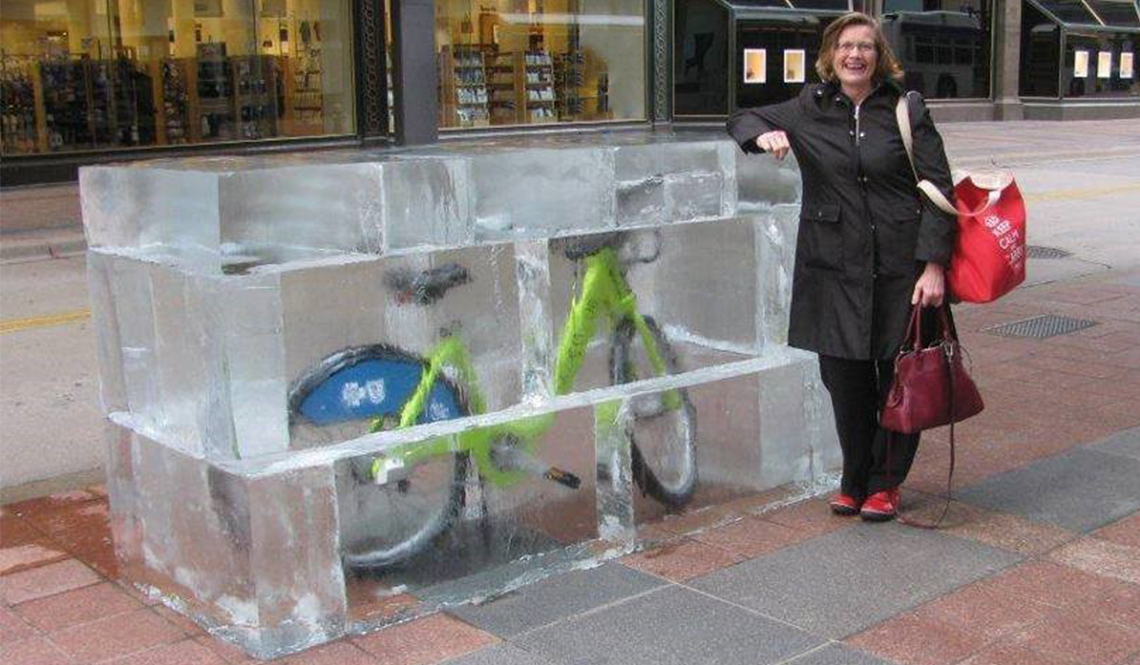Bike-sharing's past, present and future
Bike-sharing's past, present and future"
- Select a language for the TTS:
- UK English Female
- UK English Male
- US English Female
- US English Male
- Australian Female
- Australian Male
- Language selected: (auto detect) - EN
Play all audios:
Denver, Colorado, gets credit for launching the first bike-share program in a U.S. city, which it did in April 2010 with B-cycle. The Minneapolis-St. Paul Nice Ride program launched in June
2010 and considers itself to be America’s first large-scale bike-share system. As of 2018, Nice Ride features 1,850 green bikes, which were rented 460,000 times in 2017. "FROM A
CONSUMER PERSPECTIVE THIS IS AWESOME — BIKES ARE UBIQUITOUS, THEY'RE CHEAP, SOMETIMES AS LITTLE AS 15 CENTS A RIDE, AND YOU CAN OFFER MANY DIFFERENT KINDS OF BIKES, INCLUDING ELECTRIC
BIKES OR THE THREE-WHEEL BIKES SOME OLDER PEOPLE MIGHT WANT." — _Bill Dossett, executive director, Nice Ride Minnesota_ Citi Bike — launched in 2013 to great skepticism — is now the
nation’s largest with 12,000 bikes available at 700 stations throughout Manhattan and parts of Brooklyn and Queens. In 2017 alone, the bright blue bikes were used for 14 million trips, a
stat that has silenced Citi Bikes' once-vocal critics. At the start of 2018, there were about 120 bike share systems up and running across the U.S., with 28 million rides logged on the
55 largest systems in 2017. After New York, Chicago, Washington, D.C., Miami and Boston are the largest bike-share systems. But bike-shares are found in smaller towns too. Nice Ride, for
instance, helps run a system in Rochester, Minnesota (200 bikes). With roots going back to idealistic "free bike" programs in 1960s Amsterdam, the first modern urban bike-share
system was launched in Rennes, France in 1998. In 2005, the idea was picked up in Lyon, where 3,000 bikes now ply the streets. Paris adopted the idea two years later and now features almost
20,000 bikes, which are rented more than 100,000 times a day. Bike-sharing helped ignite interest in bicycling throughout France, which until then had lagged behind the Netherlands, Germany
and Scandinavian countries in two-wheel transportation. The idea has quickly spread around the world with more than 1,000 systems operating from Quito, Ecuador, to Abu Dhabi in the United
Arab Emirates to Seoul, South Korea. Bikeshare landed on North American shores in 2009 in Montreal, where 3 million people now ride bike-shares each year. China is the undisputed global
leader with as many as 50 million rides a day. EVEN MORE SHARING "Dockless bike-shares"— where a bike can be almost parked anywhere and rented with a smartphone app — are the next
big thing. Bike-sharing will no longer be limited to certain parts of town where stations are located. "They're simple to use," explains Bill Dossett, the executive director
of Nice Ride Minnesota, and a former president of the North American Bike Share Association. (Use a smartphone to take a photo of the QR code on the bike and receive a combination for the
lock.) A phone- rather than station-based system has been common in German cities for a decade. After Beijing adopted a dockless system in April 2016, the percentage of all bike trips on
city streets doubled from 5.5 percent to 11.6 percent in a year. More than 70 companies have jumped into the business of supplying dockless bikes to cities, drawing more than $3 billion in
private investment over the last year, Dossett reports. Seattle, D.C., Dallas and San Francisco are among the U.S. cities experimenting with dockless bike-sharing and trying to figure out
how best to manage bicycles being left in the middle of streets or sidewalks or other unhelpful locations. It's also too easy for an inconsiderately abandoned dockless bicycle to become
an unbreachable obstacle to people who use wheelchairs or have other mobility limitations. The problem of bikes left-behind has the potential to become a big, or even huge, problem.
"Vast piles of impounded, abandoned, and broken bicycles have become a familiar sight in many big cities," in China, reports _The Atlantic _with stunning, photographic proof. _JAY
WALLJASPER IS a Minnesota-based writer, consultant and speaker about how to create stronger, happier communities for everyone._ _Article published May 2018_ RELATED ARTICLES More from
AARP.org/Livable Use the dropdown to choose a livability topic. Select a Subject
Trending News
Abc news – breaking news, latest news and videos1 Supreme Court says Oklahoma can't launch taxpayer-funded religious charter school 2:59Playing 2 Examining Trump’s...
Page Missing Mystery | Daily ExpressThe page you requested could not be found. There could be an error in the URL you entered into your browser. Please chec...
The AARP Minute: November 28, 20221:02 AARP Videos The AARP Minute The AARP Minute: November 28, 2022 In today's "AARP Minute," why store credit cards may...
The anatomy of the knicks’ historic chokeTyrese Haliburton was right. The Knicks choked. They choked epically Wednesday night and somehow lost a game that was so...
6 Ways to Save on Egg While Prices SoarThe U.S. Department of Agriculture (USDA) announced on Feb. 26 a $1 billion plan to combat egg shortages and rising cons...
Latests News
Bike-sharing's past, present and futureDenver, Colorado, gets credit for launching the first bike-share program in a U.S. city, which it did in April 2010 with...
Not Found (#404)404Такой страницы не существует...
Why has hilary mantel maligned thomas more? | thearticleHilary Mantel’s latest novel,_ The Mirror and the Light_, has been given a spectacular reception. Mantel is a powerful a...
In brief | Nature Reviews Drug DiscoveryAccess through your institution Buy or subscribe CLICK-GENERATED TRIAZOLE UREAS AS ULTRAPOTENT _IN VIVO_ –ACTIVE SERINE ...
'Bionic Woman' show info - Los Angeles TimesNewsletter The biggest entertainment stories Get our big stories about Hollywood, film, television, music, arts, culture...
